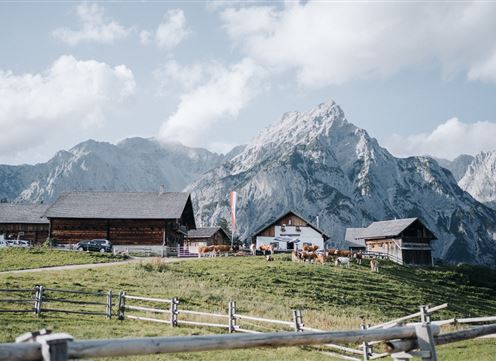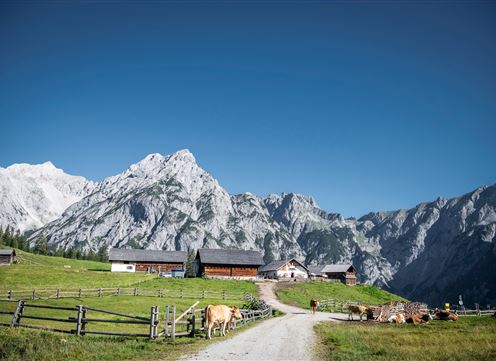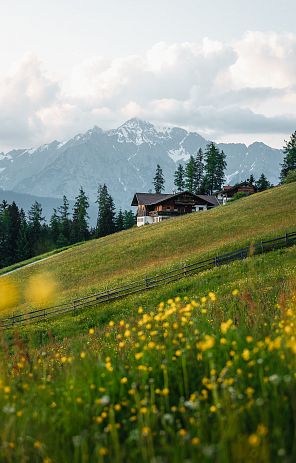Powerful Place. Walderalm near Gnadenwald
It's no secret that the Walderalm is a very popular hike for young and old alike. The reason for this is obvious: different variants and levels of difficulty of the ascent, the fantastic location nestled in the Karwendel Nature Park and the excellent hospitality speak for themselves. You can find out how to reach this special place of power in the description of the four hikes below.
The Walderalm power place at a glance
- best cheese dumplings in Tyrol
- idyllic alpine pasture in the Karwendel Nature Park
- Easily accessible for families and senior citizens
- fantastic view
- Snowshoe hike to the Walderalm
- Walderalm ponds and their revitalization
Hike to the Walderalm
It's no secret that the Walderalm is a very popular hike for young and old alike. The reason for this is obvious: different variants and levels of difficulty of the ascent, the fantastic location nestled in the Karwendel Nature Park and the excellent hospitality speak for themselves. You can find out how to reach this special place of power in the description of the four hikes below.
1st family hike Hinterhornalm - Walderalm
There are various ways to reach the Walderalm. The most popular and easiest is by car via the Hinterhornalm toll road. Park there and walk for approx. 30 minutes to the Walderalm. It is very easy to reach your destination via a wide forest path. On the right, spectacular views of the Inn Valley invite you to linger.
2nd Karwendel tour via the Hinterhornalmsteig
If you prefer to leave your car in the valley (St. Martin parking lot), you can either take the asphalted toll road or the varied trail up to the Hinterhornalm. This takes about 1.5 hours. The flora and fauna here are very impressive. From the Hinterhormalm it takes 30 minutes to reach the Walderalm, as described above.
3rd forest ascent via the Gungglkopf
We park the car a little further east of the hamlet of St. Michael. From there it is a 1.5 hour walk through the forest to the Walderalm. In the upper area, at the edge of the forest, this path meets the forest path that comes from the Hinterhornalm.
4th circular hike Ganalm - Walderalm
This scenic circular hike leads mostly through forest, but you can still enjoy many views of the mountain landscape. At Mairbach, the forest path branches off on the southern slope of the Walder Joch to the Maria Schnee chapel and the Schönblick inn. This is where the ascent from the Inn Valley to the Ganalm in Vomper Loch begins. The trail leads west along the northern slope of the Walder Joch to the rustic Ganalm at 1,190 m. Then head left on the footpath across alpine meadows or right on the forest path to the beautifully situated Walderalm. The direct descent is along the forest path to Gnadenwald. The duration of the circular hike is approx. 3.5 hours.
Walderalm, the winner of the Caspian dumpling contest
Who would have thought that the topic of cheese dumplings would cause such a stir? But let's be honest: we all like a warming soup after a strenuous hike. So it's no wonder that the TT survey (TT = Tiroler-Tageszeitung) on the best cheese dumplings in Tyrol caused such a stir. In a positive sense, of course! Cheese dumplings and mountain pastures simply belong together like a pot and a lid.
But what pleases us even more is the winner of this survey. Because the tenant Hermann Krismer from the Walderalm clearly had the edge here. So what is the secret of his cheese dumpling success? The ingredients, of course. There are 5 types of cheese and one dumpling weighs around 200 grams. On average, every third guest orders a Kaspressknödel either with salad or sauerkraut or in soup. Every day, the 61-year-old mixes five kilos of bread, three kilos of cheese, spices and more in a tub with his big hands. He laughs and says that the kneading makes his hands ache in the evening. To make the work easier, they bought a mixer a few years ago. However, the guests immediately recognized the difference, because the machine probably stirred the mixture so finely that it no longer tasted so good to the visitors. That's why Hermann now kneads and mixes the mixture by hand again.
You can find out how to make good Kaspressknödel on our blog with recipe, photos and videos.
History of the Walderalm
As the eastern foothills of the Gleirsch-Halltal mountain range, the Walderalm has long been enthroned above the Inn Valley in the south and the secluded Vomperloch in the north. The rustic huts that huddle together in the heart of the panoramic alpine pasture area transport modern visitors back in time. As in many places in alpine farming, the centuries-old tradition is still surprisingly present on the Walderalm - but there are not many reminders of the special features of its history.
As area names and finds show, the Karwendel was already inhabited in pre-Roman times and it can be assumed that these early mountain dwellers drove their cattle to high pastures in summer. It is unlikely that this was also the case here, as the wooded area is first mentioned as Schwaighof in the Middle Ages and was therefore primarily dedicated to clearing.
The roots of alpine farming lie in the 15th century, the beginning of silver mining in Schwaz. From the foot of the Großer Lafatscher, miners transported the lead ore mined there via the Vomperloch and the Walderalm into the Inntal valley. Only the exposed "Knappensteig" trail still gives a telling indication of this time. The miners were probably the first to drive cattle onto the cleared areas in summer and thus use the Walderalm as grazing land.
Whether the miners also stayed in winter is just as unclear as the question of the division of labor. However, the fact that farmers and squires restricted themselves to their métier is suggested by the transition to independent alpine pasture farming, which from then on was carried out jointly by several owners. Originally there were eight of them (today there are only three), but as early as 1598 everyday life on the alp was regulated by numerous agreements between the farmers and the neighboring forest owners. Because the Walderalm was also used as a forest pasture in addition to the open areas, there is still a forest-pasture separation today that clearly distinguishes the rights of use. The 75 cows still graze between larches and spruces on the 200-hectare alpine pasture, which extends down into the Vomperloch.
In its inaccessible depths, up to twenty deserters - one of the largest groups of deserters in the whole of Austria - successfully hid from the Gestapo in the last two years of the Second World War. Shortly before, in 1935/36, forced laborers built a road from Gnadenwald so that milk no longer had to be transported on horseback or even on one's own back. The asphalted toll road to the Hinterhornalm then made it possible to collect the milk conveniently by truck every morning.
Source: Karwendel Nature Park
Excursus to the Schwaighöfe farms:
Schwaighöfe were mostly located above the upper settlement limit (1200-1600 m above sea level) and were year-round inhabited individual farms that were used almost exclusively for livestock farming. They developed in the settlement and economic form of the 12th-14th centuries throughout the Alpine arc. In Latin documents they are called: "curia armentaria, vaccaria, olive and also swaigalis". The name "Schwaige" means "cattle yard or herd". Such farms were built and furnished by the lord of the manor and stocked with five to six cows and 20-30 sheep and goats. Because hay storage had not yet become widespread at that time, the animals were often dependent on foraging in the forest pastures in winter, so that they could only survive the long snowy months in hunger. And because grain cultivation was usually not possible, the new settlers in these remote areas were even allocated grain and salt by the landlord, but had to pay him ground rent. Mostly in the form of low-fat cheese, rarely with meat or live domestic animals and even more rarely, but very valuable on the market, with clarified butter.
Such Schwaighöfe opened up previously uninhabited and often unused high altitudes and valley heads. However, many of these permanent settlements were soon abandoned due to longer periods of cold weather or changes in the economic situation, and industrialization in the early 19th century turned the last Schwaighöfe into mountain pastures again, which only continued to farm the grazing areas in summer.
The Maria Schutz chapel east of the Walderalm
In 1965-67, a chapel was built on the eastern slope above the mountain pasture on the initiative of Innerebner Josef, KR Zährer and Platzer Hans. It is intended as thanks for the fact that some soldiers returned home from the terrible war. It is consecrated under the name "Maria Schutz". When the chapel gate is open during an alpine mass, visitors can admire the magnificent mountain world of the Karwendel through the northern window like a constantly repainted altarpiece.
The Walderalm ponds: Revitalization by the Karwendel Nature Park
The Walderalm and its ponds have always been a popular photo motif. However, in the 1990s, the quality of the Walderalm ponds suffered massively in every respect. In the end, they turned out to be massively over-fertilized cesspools overgrown with duckweed and algae that were, in a word, "unsightly". This development was accompanied by a severe loss of biodiversity among aquatic species such as amphibians and dragonflies. Unfortunately, for a very long time it was not possible to work out a project that met the expectations of the landowners and grazing rights holders as well as the interests of nature conservation. It was not until 2011 that a rapprochement was reached and a project was drawn up by the Karwendel Nature Park, which included the following aspects: dredging of the two ponds under appropriate nature conservation conditions and independent ecological construction supervision, the construction of a small observation platform and the permanent release of pasture around the ponds. The latter is particularly important in order to achieve a sustainable effect. The grazing was implemented by means of a traditional fence, which can also withstand the high snow pressure in winter.
Today, the revitalization of the Walderalm ponds has been completed. However, some work such as mowing, erecting fences etc. is required every year to ensure that the ponds retain their splendor. In order to preserve the Walderalm as a "total work of art", it is necessary to continue to keep an eye on it and find solutions in the area of conflict between alpine pasture management and nature conservation.
Volunteers can always help with maintenance work on the Walderalm ponds. You can find more information on the Karwendel Nature Park website.
Source: Karwendel Nature Park
The Walderalm ponds: Habitat of alpine newt & Co.
Especially above the tree line or in the alpine pasture area, open water areas are few and far between. In this respect, the Walderalm ponds fulfill a variety of functions. They are not only a feast for the eyes, but also a habitat for numerous animal and plant species. Some typical species are briefly presented here.
In early spring, alpine newts make their way to the ponds to breed. In the course of the early summer, they are joined by numerous other animals. The most conspicuous are the various dragonfly species, some of which hunt other insects just above the surface of the water. Eight different species were recorded in the first year after the revitalization. New ones were added in the second year. It can also be assumed that other species will choose the Walderalm ponds as their habitat over time. Another prominent newcomer is the yellow fire beetle, whose larvae, similar to dragonfly larvae, are among the most feared hunters under the water surface.
In summer, the first newt larvae emerge, which are easy to recognize with their gill tufts. A grass snake has also already made its appearance.
Of course, there are also numerous water-bound plant species that colonize the ponds, such as the protected feverfew, which has survived the construction work very well, or the sometimes quite rare Armleut algae, which has deposited lime in its interior. Also important are the various sedge species that help to clean the water around the edges and provide good hiding places for the animal species mentioned above. The marsh marigold or the spotted orchid also find good living conditions in the wetter areas or ditches. All of these and many others form the so-called "pond community".
Source: Karwendel Nature Park








